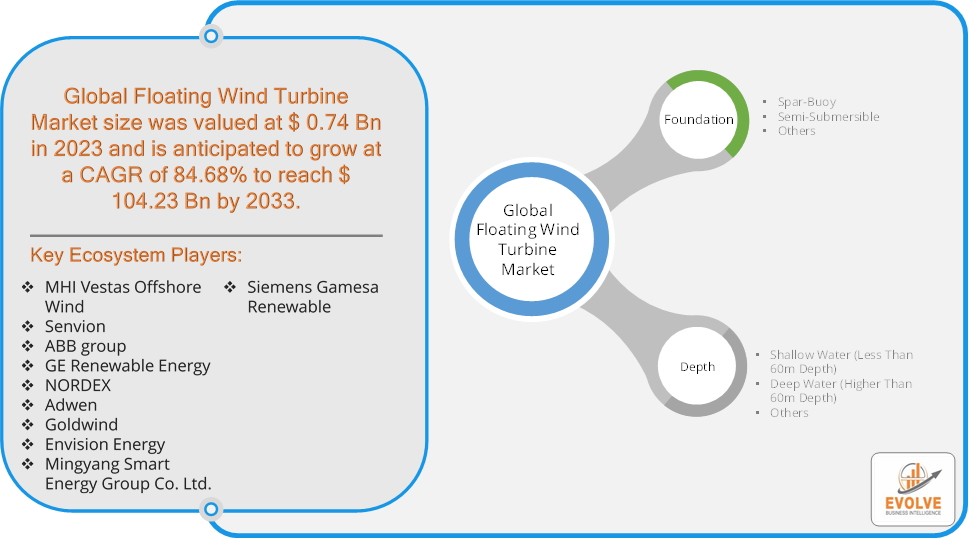Evolve Business Intelligence has published a research report on the Global Floating Wind Turbine Market, 2023–2033. The global Floating Wind Turbine Market is projected to exhibit a CAGR of around 84.68% during the forecast period of 2023 to 2033.
Evolve Business Intelligence has recognized the following companies as the key players in the global Floating Wind Turbine Market: MHI Vestas Offshore Wind, Senvion, ABB group, GE Renewable Energy, NORDEX, Adwen, Goldwind, Envision Energy, Mingyang Smart Energy Group Co. Ltd. And Siemens Gamesa Renewable.
 More Information: https://evolvebi.com/report/floating-wind-turbine-market-analysis/
More Information: https://evolvebi.com/report/floating-wind-turbine-market-analysis/
Market Highlights
The Global Floating Wind Turbine Market is projected to be valued at USD 104.23 Billion by 2033, recording a CAGR of around 84.68% during the forecast period. The Floating Wind Turbine Market refers to the industry involved in the development, production, deployment, and operation of wind turbines mounted on floating structures in offshore locations. Unlike traditional offshore wind turbines that are fixed to the seabed, floating wind turbines are anchored to the ocean floor using mooring systems, allowing them to be placed in deeper waters where wind resources are typically stronger and more consistent.
The floating wind turbine market represents a promising area within the renewable energy sector, offering a sustainable solution to harnessing offshore wind resources and contributing to the global shift towards clean energy.
The COVID-19 pandemic had a significant impact on the Floating Wind Turbine Market. The pandemic caused disruptions in global supply chains, leading to delays in the manufacturing and delivery of key components such as turbines, blades, and floating platforms. Restrictions on movement and temporary shutdowns of factories impacted production schedules. Social distancing measures and lockdowns affected the availability of personnel and equipment for the construction and installation of floating wind farms, leading to project timelines being extended. The pandemic slowed down permitting processes and regulatory approvals, as government agencies faced operational challenges and shifted priorities. The pandemic underscored the need for resilient energy systems, reinforcing commitments to transition to renewable energy sources, including floating wind. The pandemic accelerated the adoption of digital technologies and remote monitoring systems to manage operations and maintenance of wind farms, reducing the need for on-site personnel.
Segmental Analysis
The global Floating Wind Turbine Market has been segmented based on Foundation and Depth.
Based on Foundation, the Floating Wind Turbine Market is segmented into Spar-Buoy, Semi-Submersible and Others. The Spar-Buoy segment is anticipated to dominate the market.
Based on Depth, the global Floating Wind Turbine Market has been divided into Shallow Water (Less Than 60m Depth), Deep Water (Higher Than 60m Depth) and Others. The Deep Water segment is anticipated to dominate the market.
More Information: https://evolvebi.com/report/floating-wind-turbine-market-analysis/
Regional Analysis
The Floating Wind Turbine Market is divided into five regions: North America, Europe, Asia-Pacific, South America, and the Middle East, & Africa. In North America region, the U.S. has vast offshore wind resources, particularly on the West Coast and in the Gulf of Mexico, where floating wind technology is essential due to deep waters. States like California and Maine are pursuing floating wind projects. Abundant resources and growing policy support offer potential for expansion, but regulatory uncertainty and high initial costs are obstacles to overcome. Europe is at the forefront of the floating wind turbine market, with several projects already operational and many more in the pipeline. The European Union’s commitment to renewable energy and decarbonization goals has resulted in favorable policies, subsidies, and incentives for floating wind projects. The Asia-Pacific region is rapidly emerging as a significant market for floating wind turbines, driven by energy demand and renewable energy goals. Although more focused on fixed-bottom offshore wind, China is exploring floating wind projects, particularly in deep-water areas. Rapid industrial growth and energy demand present significant opportunities, although regulatory hurdles and the need for technological advancements pose challenges. Latin America region, primarily focused on other renewable sources like solar and hydroelectric, there is potential for floating wind in countries like Brazil, with its extensive coastline and deep waters. The Middle East and Africa regions are not yet major players in the floating wind market but could explore opportunities in the future as technology costs decrease and the demand for renewable energy grows.